Columbus Chill Timeline
May 17, 1991
East Coast Hockey League announces that a Columbus franchise has been included in the league’s schedule for the 1991-92 ECHL season.
July 23. 1991
State Controlling Board approved a five-year agreement between Columbus Hockey Inc. and the Ohio Expositions Commission.
July 26, 1991
Franchise officially announced to public with David Paitson, 31 year old sports marketing veteran named as team President and General Manager. Chill nickname, logo and team colors of black and silver introduced to the media.
July 31, 1991
15-year NHL veteran player Terry Ruskowski named Chill’s first coach.
October 10, 1991
Jason Christie, a.k.a. “The Smurf” becomes the first player ever to sign a contract to play for the Columbus Chill.
November 1, 1991
The Columbus Chill plays its first ever home game in front of 6,298 patrons at the Ohio Expo Center Coliseum. Later, reports indicate as many as 7,000 may have been packed into the 5,700 seat facility. Final score Columbus Chill 7 Erie Panthers 5.
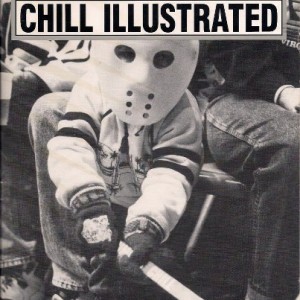
December 13, 1991
At the Chill versus Toledo Storm game the team gives away 2,000 replica goalie masks, similar to those worn by the Jason character in the “Friday the 13th” slasher films. A television commercial is created in the “Friday the 13th” theme to support the promotion. The commercial wins an ADDY award, presented by the American Advertising Federation.
December 24, 1991
Chill releases “Home for the Holiday’s” video to Columbus television stations. The nearly two minute promotional film is aired multiple times over the holidays at the enthusiastic requests of the fans.
December 31, 1991
The Tuesday, December 31 edition of the Wall Street Journal includes a story “Chill Scores with Puckish Promotions.” The story tabs the Chill as “hockey for the hip.”

January 5, 1992
Chill begins minor league record breaking sellout streak, after selling out for the Chill vs. Roanoke game. The Chill would sell out 83 consecutive games and 191 of 252.
January 17, 1991
ABC World News Tonight sends a crew to Columbus to do a story on the Chill franchise. The five-minute piece promoting the Chill’s “merry marketers” airs before a national audience on ABC’s World News Tonight Sunday, January 25th.
February 1, 1992
Chill front office strategically decides to place 1992-93 season tickets on sale to strike while the iron was hot. At 5:30 a.m. on Saturday, February 1, fans formed lines outside the Chill offices to purchase tickets. Over 750 season tickets were sold the first weekend. The team builds on its inaugural season ticket base of 1,200 and climbs to more than 5,000 season ticket holders for its second year.
September 4, 1992
Columbus Dispatch reports a major conflict over Chill home playing dates, left unresolved by ousted Fairgrounds manager Billy Inmon. The problem places the Chill’s 1992-93 hockey season in jeopardy. Chill officials called upon their fans to voice their displeasure to government officials and the media. The fans respond by in full force with calls and letters. Reportedly more than 400 letters were received at the Columbus Dispatch alone. Paitson visits with Columbus Mayor Greg Lashutka who offers to assist in solving the dilemma.
September 10, 1992
With public outrage ignited and the scheduling fiasco still an open issue, Mayor Lashutka announces his intention to form a “Citizens Commission.” Columbus developer Ron Pizzuti, former OSU basketball star and television analyst Bill Hosket and Guy Cole a federal judge on the U.S. Court of Appeals for the Sixth Circuit are appointed to study “how and where a sports/civic arena might be built in Columbus.”
September 14, 1992
New Fairgrounds General Manager Mark List announces an agreement to resolve the scheduling. Three events – Dispatch Sport, Vacation and Travel Show, the Buckeye Gymnastics Classic, and the Scott Antique Market – shift dates or venues to make way for the Chill dates.
November 6, 1992
Chill opens its second home season with a sellout crowd of 6,000.
December 31, 1992
Chill host “Turn Back the Clock” a unique New Year’s Eve promotion designed as a spoof of baseball promotions of the same name. With no history of its own, the Chill selects 1967’s “Summer of Love” as its theme. Tie-die jerseys are worn for the first time in a professional hockey game. The game is also the 25th consecutive sellout breaking the old minor league record for consecutive sellouts by Cape Breton of the American Hockey League.
February 20, 1993
Chill finishes second season selling out all 32 home games.
October 3, 1993
Ignited by the success of the Columbus Chill, President and General Manager David Paitson convinces Chill owner Horn Chen to invest in a state of the art ice facility to later be known as the Dublin Chiller. The Chiller becomes the official practice facility for the Chill and a public skating facility. The Chill becomes the first minor league hockey team to own and operate its own ice facility. Paitson is named President of the Chillers, in addition to his lead role with the Chill. In four years, over 20,000 area residents participate in learn-to-play-hockey and learn-to-skate classes, making the Chillers the largest ISI (International Skating Institute) program in the country. From the arrival of the Chill to its end in 1999, the number of youth hockey players in the area increased from 150 to more than 1,300.
October 19, 1993
Five veteran players – Mark Cipriano, Jason Christie, Darren Perkins, Rob Schriner and Mark Wolfe walk out of practice over a money dispute. The dispute plays out in the press with fans loyalties siding primarily with the players. Bound by a mandatory ECHL salary cap, the Chill elect to trade Christie and Perkins, but keep Cipriano, Schriner and Wolfe. WBNS (CBS) breaks into local soap operas to show Jason Christie cleaning out his locker for the last time.
November 3, 1993
On Opening Night, for its third season the Chill players enter the by limousine. Held as a secret even to the team until the last possible moment, the limos drove onto the ice, all the while being shaken by the players inside, to the roaring sellout crowd of 6,000.
December 26, 1993
For the first time in team history the Chill takes over first place in the North Division after a 6-3 win over arch-rival Toledo Storm.
December 31, 1993
56th consecutive sellout ….Chill hosts third annual New Years Eve game featuring the Turn Back the Clock promotions. The theme was “Turn Back the Clock” to 1967. Chill players wear tie-dye jerseys as part of promo.
February 23, 1994
For the first time in franchise history the Chill clinched a spot in the ECHL playoffs with a 7-4 win over the Johnstown Chiefs.
February 28, 1994
Chill playoff tickets go on sale for the fast time. Ninety percent of the season ticket holders buy playoff tickets. Later when season tickets go on sale the demand for season tickets becomes so great the Chill creates a second mini-season ticket plan is added. In addition a season ticket waiting list is started with over 1,000 people on it. With a full season ticket limit of 2,500 and two mini-season ticket plans the total number of fans owning season tickets grows to 6,500.
March 14, 1994
WCMH NBC 4 preempts prime time network programming to air first Chill home playoff game live, a rarity in minor league sports. The Chill defeat Johnstown 9-4.
March 26, 1994
Chill franchise wins first playoff series 2-1 over the Johnstown Chiefs.
April 20, 1994
Chill head coach Terry Ruskowski takes the head coaching job with the Houston Aeros of the International Hockey League. Ruskowski’s marks the first time an ECHL coach was promoted directly to a head coach in either the American Hockey League or the IHL.
May 14, 1994
The Central Ohio Chapter of the American Marketing Association recognizes the Columbus Chill as the Marketing Project of the Year.
June 30, 1994
After an extensive search of over 75 applicants, Chill hire Moe Mantha, a 12-year NHL veteran and former USA Olympian to become the second ever coach for the franchise.
November 2, 1994
Chill opens its fourth season in front of a sellout crowd of 5,800.
November 20, 1994
The Chill hosts the Johnstown Chiefs in front of 5,434 fans. The game is not a sellout marking the first non-sellout after 83 consecutive games sold a capacity.
December 14, 1994
More than two years after the Coliseum scheduling fiasco, and a year after the formation of Mayor Lashutka’s Citizens Commission, a downtown arena feasibility study from the Chamber of Commerce is unveiled. The plans are introduced by Chamber President Jonathan York and Citizens Commission leader Ron Pizzuti. The study states that with the Chill as the main tenant, the facility would break even financially. Chill president David Paitson is a featured speaker at the press conference and endorses the facility and verbally commits the Chill to play in the proposed arena.
December 31, 1994
Chill hosts second annual “Turn Back the Clock” night in their game versus the Dayton Bombers. The team turns back the clock to 67 A.D. As part of the promotion the Chill players wear Roman numerals on their jerseys and Moe Mantha is carted onto the ice in a chariot. A banner with the Roman numeral LXXXIII, signifying the Chill’s record breaking 83 game home sellout streak is lifted to be displayed in the Coliseum rafters.
March 19, 1995
The Chill sells out final home game of the 1994-95 ECHL season. The team sells out 31 of 34 home dates.
March 29, 1995
Franklin County joins the city of Columbus in the arena and stadium efforts. The Multi-Purpose & Sports Facility Work Group is formed by Mayor Lashutka, the Franklin County Commissioners, Chamber of Commerce and the Franklin County Convention Facilities Authority. Two representatives from each entity are appointed to the 10-person work group – with two private businessmen included in the group. They are: Doug Kridler of the Columbus Association for the Performing Arts (CAPA) and David Paitson, President and General Manager for the Columbus Chill.
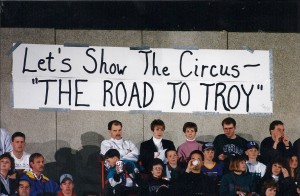
April 1995
Due to a conflict of dates the Chill must play their first round playoff series at Troy Arena in Dayton, Ohio. It would be the first of several instances where the Chill would be displaced from the Coliseum for home playoff dates.
May 19, 1995
A Chill radio spot is selected as a national finalist for the Silver Microphone Award.
October 1995
Under second-year coach Moe Mantha the Chill open the season with their best start in franchise history going 8-2 in their first 10 games, all of which were on the road. The long road trip is due to Coliseum being unavailable because of the annual Quarter Horse Congress.
November 4, 1995
Chill open fifth home season in front of a sellout crowd of 5,800.
Winter, 1996
National Hockey League notifies leaders of various cities that the league would be adding several franchises. When the mayor of Columbus was contacted, he in turn contacted John H. McConnell and Ronald Pizzuti. Pizzuti contacted several other people, including Lamar Hunt, and a consortium of groups formed an LLC, Columbus Hockey Limited (CHL) for the purpose of obtaining a franchise for Columbus. Each member of CHL contributed part of the $100,000 application fee for the franchise.
March 23, 1996
Chill sellout their final home game in front of 5,900 people. For the season the team sells out 27 of 35 games.
April 29, 1996
A Chill radio spot titled “Jingle” is awarded an ADDY presented by the American Advertising Federation.
April 25, 1996
Chill coach Moe Mantha resigns to become the head coach of the London Knights of the Ontario Hockey League. Later Mantha rescinded the offer and was hired as the head coach of the Baltimore Bandits of the AHL. The Bandits and Mantha later moved to Cincinnati and became the Mighty Ducks.
June 28, 1996
Seven representatives from Columbus including Chill President and General Manager David Paitson meet with NHL Commissioner Gary Bettman in New York to discuss expansion.
July 17, 1996
Brian McCutcheon is introduced as the Chill’s third-ever head coach.
October 25, 1996
Columbus Mayor Greg Lashuta tells the Columbus Dispatch “It would be very helpful to us to have an NHL expansion team being awarded, but I don’t think it is fatal (to the arena issue) if that doesn’t happen. We’ve already shown that the economics of the arena work as an entertainment facility and with the Chill.”
November 1, 1996
Chill open seventh home season in front of a sellout crowd of 5,800. The same day a Columbus NHL expansion application is submitted.
December 31, 1996
Chill hosts annual “Turn Back the Clock Night” vs. the Dayton Bombers this time returning to 1981. Following the game the team hosts a post-game party in the round room adjacent to the Coliseum. WNCI radio co-hosts the party with its Friday Night 80s deejays. The party features the popular 80s one-hit-wonder band Flock of Segalls. Over 2,000 attended one of the largest and most animated New Years Eve parties in city history.
March 17, 1997
Chill coach Brian McCutcheon becomes the first Chill coach to be named ECHL Coach-of- the-Year.
March 30, 1997
With a Chill 4-1 victory over the Toledo Storm, Columbus wins the North Division title marking the first time in the history of Columbus hockey that a team won a division title.
April 2, 1997
Due to conflicts with the Ohio Expo Center the Chill are forced to play their home playoff games at the Nutter Center in Dayton. Only one month before the infamous Issue One vote, the controversy ignites Columbus’s dire need for another facility to host sporting events.
April, 1997
The Chill and Columbus Blue Jackets owner John McConnell join forces and sign a deal to build a second Chiller in the Easton Market area.
May 6, 1997
In a monumental defeat, Issue One fails at the ballot box by 12 points. The loss seemingly ends any hope of Columbus receiving an NHL expansion franchise.
May 9, 1997
In the days that followed the defeat of Issue One, NHL commissioner Gary Bettman reaches out to Columbus Mayor Greg Lashutka giving Columbus a June 4th deadline to provide an alternative proposal. Dimon McFerson of Nationwide Insurance meets with Lamar Hunt to discuss the possibility of privately building the arena. At that point, the Columbus franchise was to be owned by Hunt with several local investors including John H. McConnell, John Wolfe and Ron Pizzuti.
May 30, 1997
Chill President and General Manager David Paitson named the ECHL Executive-of-the- Year.
May 30, 1997
Lamar Hunt rejects several leasing proposals by Nationwide for the new facility. When a deal seemed to be in jeopardy, Nationwide, who was committed to building the arena privately, contacted McConnell to see if he would personally move forward on a deal if Hunt would not. Hunt did not respond to Nationwide’s deadline of May 30th. With the NHL’s June 4th deadline looming Nationwide notified the NHL that McConnell would apply as the principal owner representing Columbus’s request for an expansion franchise.
June 2, 1997
Nationwide Mutual Insurance Cos. unveiled plans to privately finance a $125 million Downtown arena.
June 25, 1997
The NHL Board of Governors selects Columbus for a NHL expansion franchise, scheduled to begin play in October 2000. Nashville (to begin play in 1998), Atlanta (1999) and Minnesota (2000) are also selected. John H. McConnell is the principal owner of the franchise.
August 12, 1997
Chill coach Brian McCutcheon becomes the third Chill coach to climb the coaching ladder. McCutcheon is hired by the Buffalo Sabres organization and assigned as head coach AHL’s Rochester Americans. The hiring marks the third of seven-ever ECHL coaches to get hired as head coaches in the AHL or IHL. McCutcheon would later become Associate Head Coach of the Sabres.
August 26, 1997 Chill hire ex-player Don Granato as the team’s fourth and final head coach. Granato had just completed back-to-back USHL championships with the Green Bay Gamblers. It was the first team to repeat in league history.
Summer, 1997
To clear the way for the Blue Jackets to have sole ownership of the hockey market, Paitson brokers a deal with the McConnell organization. Chill owner Horn Chen receives a small percentage ownership stake in the NHL expansion franchise and begins to search for a buyer for the ECHL franchise.
October 26 – November 1, 1997
In what has become Columbus hockey folklore, the Chill created the ultimate bait & switch promotion. The Chill would capitalize on the intensity of the excitement of the NHL expansion franchise nickname announcement, as Chill President David Paitson conceptualized a strategic misdirection. Opening Night was schedule for Halloween.
Four days before the home opener, the Chill issued a one line press release stating that there would be a press conference on Thursday – one day before Opening Night – “to announce a team name change.” The media was caught completely off guard and leapt to the incorrect conclusion that the Chill was changing its name in order to be used as the name for the new NHL franchise.
Paitson, who had been fascinated and entertained by a campaign from The Other Paper with their NHL nickname suggestion of the Mad Cows, secretly approached the Publisher Max Brown and staff to play along with the gag. In the spirit of Halloween, the Chill would “change costumes” and be transformed into the Mad Cows for Opening Night.
The duped media would forgive the Chill and embrace the prank. Opening Night would be transformed into the “Meadow of Doom” with hundreds of fans in costume, a 40-foot inflatable cow at a pre-game party, and an intermission contest where fans dunked for cow tongues. The promotion not only helped the Chill to a sellout, but had delivered even more attention and interest in the NHL team nickname announcement that occurred 10 days later.
December 11, 1997
The Chill becomes the only franchise other than the Anaheim Mighty Ducks to co-own and operate two ice facilities. The explosion of youth hockey is on. Also, under the Chill’s direction, the Easton Youth Hockey League is formed, making it the third youth hockey organization in Columbus.
December 31, 1997
The Chill host its final “Turn Back the Clock” night. The theme returns to the 1976 American Bicentennial. The players wear bicentennial jerseys of red, white and blue. In addition the ice was also covered with the stars and stripes. Chill ticket manager Evonne Segal sings the national anthem in full Statue of Liberty costume.
March 28, 1998
The Chill finishes its seventh season promoting a franchise record 18 different players to the IHL or AHL. Over the course of the team’s history over 100 players advanced their careers to higher level leagues, include five to NHL rosters.
May 22, 1998
Chill President and General Manger David Paitson officially join’s the Columbus Blue Jackets staff. Paitson is the last of the original members of the Chill front office who have moved on to other jobs. Over 30 former Chill employees have advanced their careers to the NCAA, NHL, NBA, AHL, IHL, ECHL, and NFL. Eight additional people affiliated with the Chill organization ultimately join the Blue Jackets including trainer Chris Mizer, equipment manager Jason Stipinski, front office members Gary Kohn, Jason Rothwell, Nora Ludwig, Aylish Costello, Chiller ice technician Mike Sims and attorney Greg Kirstein. Also, team photo Greg Bartrum and several members of the minor officials crew including Dan Grassbaugh, Joe Mongolier, Ron Mongolier, Don Gullata, Don Supelak, Larry Wilson, Doug Reed and Steve Haller move over to the Blue Jackets in game day roles.
September 15, 1998
The Columbus Chill signs a radio contract with WFII 1230 AM to broadcast all 70 regular season games. The 70-game contract + playoffs marks the first time professional hockey in Columbus broadcasts an entire season.
September 24, 1998
Chill franchise announces the team has been sold to SMG and the 1998-99 ECHL season will be the franchises last in Columbus. The franchise would be relocated to Reading, Pennsylvania.
October 1, 1998
Fan favorite Jason Christie rejoins the team as the player/assistant coach.
October 16, 1998
Chill opens eighth and final season – themed “Last Call” – to a sellout crowd. Home opener includes an appearance first-ever Chill coach Terry Ruskowski.
December 31, 1998
Chill host final “Turn Back the Clock” night, however for its final New Years Eve Bash the team turns the clock forward dubbing the evening “Swing Into 1999.”
January 22, 1999
Chill complete the last of three events in tribute to the former hockey teams in Columbus. During the course of the season, the Chill wore replica jerseys worn by the Checkers, the Seals and the Owls.
January 24, 1999
In a fan vote, the Chill All-Time team is announced:
- Lance Brady, Defenseman
- Barry Dreger, Defenseman
- Derek Clancey, Forward
- Jason Christie, Forward
- Rob Schriner, Forward
- Jeff Salajko, Goal Tender
- Phil Crowe, Enforcer
February 4, 1999
Bret Meyers becomes the first Chill player to ever start an ECHL All-Star game.
March 14, 1999
Team wins a franchise-best 25th game at home and bids for the Northwest Division title.
April 4, 1999
“Last Call” – Chill plays final regular season home game in front of its 191st sellout crowd of 5,846 on Easter Sunday. Jason “Smurf” Christie scores the first, and what would become the game winning goal as the Chill defeat archrival Dayton Bombers 5-0 to earn the Northwest Division title, edging the Bombers in the all-time series. The team would wear its inaugural season style jerseys to honor its eight great years of hockey. The triumph ended with the traditional season ending stick salute to the fans by the players. In a post game celebration select fans were honored for their loyalty and given jerseys off the back of the players. Head coach Don Granato was presented his first-year Chill jersey he wore as a player. Friends of the franchise, game night personnel and front office personal were recognized for their efforts.
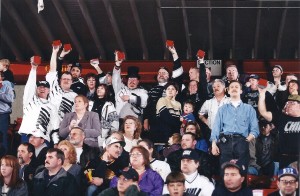

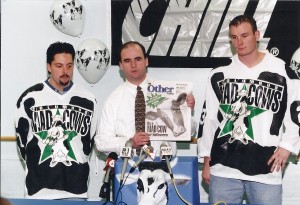
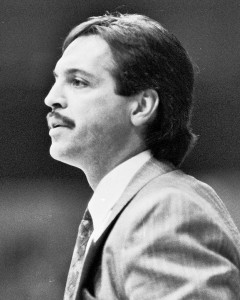
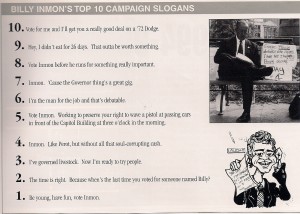
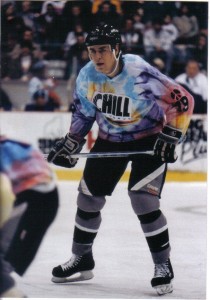
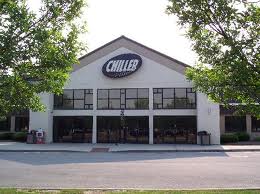
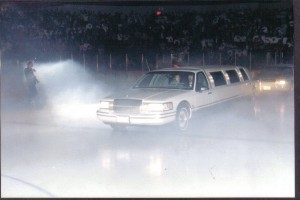
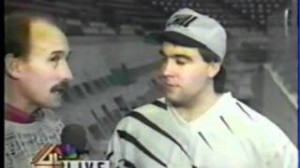

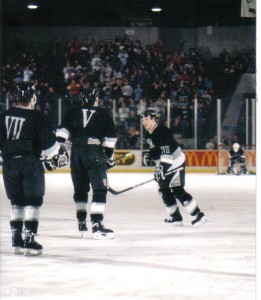
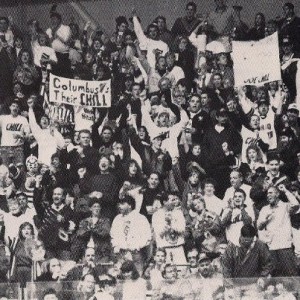
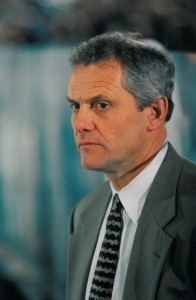
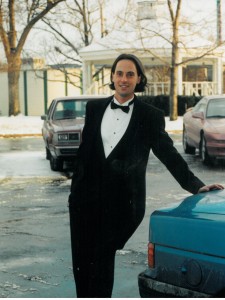
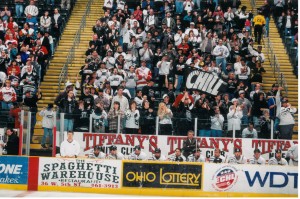
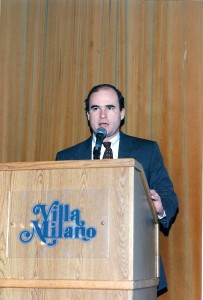
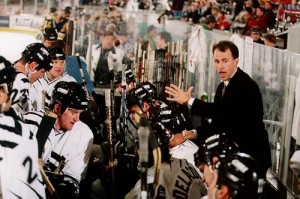
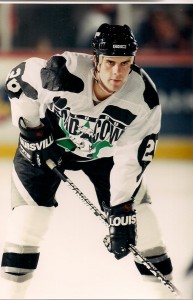
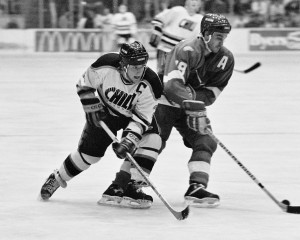
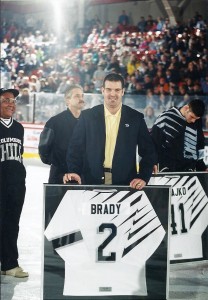
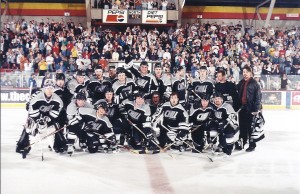
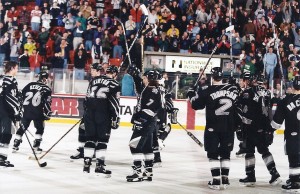

This post has no Comment